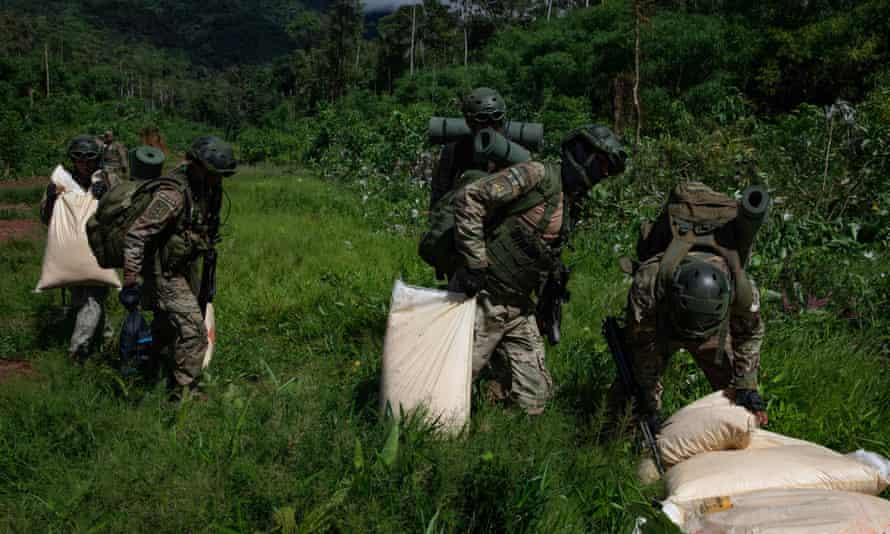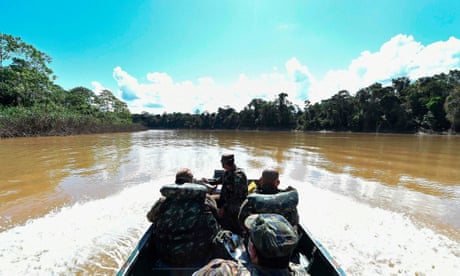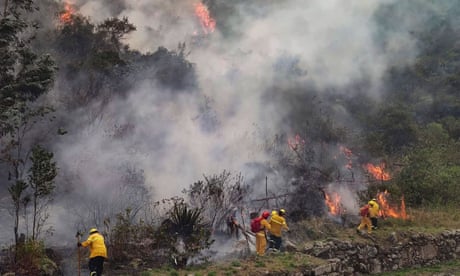LEGALIZE DRUGS END WAR ON DRUGS
‘Set of failures’: are Peru’s gains in the drug war a loss for the Amazon?
A 2015 aerial view of the Esmeralda Base in the VRAEM area, some 280km south east of Lima.
Photograph: Cris Bouroncle/AFP/Getty Images
In Vizcatán, the last redoubt of militarily active Maoist rebels Shining Path, the army is cracking down on cocaine traffickers
Dan Collyns at the Valle Esmeralda base
THE GUARDIAN
 A coca farmer works with coca leaves in Rosario district, Ayacucho department, Peru. Photograph: Ernesto Benavides/AFP/Getty Images
A coca farmer works with coca leaves in Rosario district, Ayacucho department, Peru. Photograph: Ernesto Benavides/AFP/Getty Images
The top brass is convinced the Shining Path remnants are on the back foot: Victor Quispe Palomino, ‘Comrade José’, is the last of three siblings which led the band. The US State Department has offered a reward of up to $5m for information leading to the 61-year-old’s arrest or conviction.
As a show of intent, journalists were shown a seizure of nearly two tonnes of refined cocaine piled in bricks at Los Sinchis army base in the frontier town of Mazamari – the result of a joint raid by police and army special forces.
The potential profit margin for smugglers is like that of no other product on earth. One kilo of cocaine hydrochloride worth around $1,000 in the VRAEM could be worth hundreds of times more if it reaches Saudi Arabia or China.
But coca represents an important income for the coca growers, who make up much of the valley’s 650,000 inhabitants. It provides easy money to pay for basic needs in a region which lacks sanitation, electricity and basic infrastructure.
 Members of the Peruvian Armed Forces destroy a clandestine airstrip in the VRAEM. Photograph: Sebastian Montalvo Gray/EPA
Members of the Peruvian Armed Forces destroy a clandestine airstrip in the VRAEM. Photograph: Sebastian Montalvo Gray/EPA
“But in no way does [coca] lift them out of poverty,” says Gustavo Gorriti, a Peruvian investigative journalist and a veteran of the country’s drugs war. “The traffickers want to keep them in it.”
The military advances in VRAEM mean traffickers are looking for new places to grow coca with less intervention from the state security forces. That has led to a balloon effect as drug traffickers and coca farmers are squeezed out in one area, then pop up in another.
That means Indigenous territories to the north of the VRAEM in Ucayali, Huánuco and Loreto regions are increasingly under threat as traffickers invade their lands.
“The balloon effect is going to happen anyway,” Gen Gómez de la Torre told the Guardian. “When we pacify the area our troops are going to have to leave the area. As in any part of the world, the military apparatus moves to where the threat is.”

Police losing narco war in deadly Amazon region where duo disappeared
Increasingly that threat is on Peru’s north-eastern frontier with Colombia and Brazil, the dangerous triple frontier where Dom Phillips and Bruno Pereira were murdered.
It also lies along Peru’s Amazon border with Brazil and Bolivia where drug flights are a daily occurrence.
Global manufacturing of cocaine reached a record high in 2020, according to the UN report, and of the three countries that grow coca bushes to make cocaine, Colombia showed a slight decline (-7%) which was more than offset by increases in Peru (13%) and Bolivia (15%). However, Colombia, with 61% of the total, continued to be the country in the world with the highest level of coca plantations.
A record 21.5 million people used the drug in 2020, the report estimated, an increase coupled with rising consumption in South America which doubled over the last ten years.
Without more backing and resources from consumer countries to interdict trafficking along Peru’s 10,000km land and sea border, little will change, said Gorriti.
“All Peruvian anti-drug strategies are, and with very few exceptions have been, a set of failures and counterproductive actions that have produced cosmetic results,” he added.
“They have not affected the growth and movement of drug trafficking and its effects.”
In Vizcatán, the last redoubt of militarily active Maoist rebels Shining Path, the army is cracking down on cocaine traffickers
Dan Collyns at the Valle Esmeralda base
THE GUARDIAN
Wed 6 Jul 2022
Sitting on a bluff overlooking the Tambo River, the Valle Esmeralda counter-terrorist base is only accessible by helicopter or a very long hike. It is strategically located to have a bird’s eye view of Vizcatán, the last redoubt of the only militarily active remnants of the Shining Path, the brutal Maoist rebels who terrorized Peru in the 1980s and 90s.

Peruvian firefighters contain blaze near Machu Picchu after three days
It is a rugged terrain of thickly forested mountains, steep canyons and fast-flowing rivers on the Amazon’s western edge which rises into the dry, treeless Andes. Its landscape and the Mantaro river which snakes away from jungle lowlands and through the mountains make it the ideal route for backcountry cocaine trafficking.
Vizcatán is one part of a huge stretch of jungle known as VRAEM (an acronym for the valley of the Apurimac, Ene and Mantaro rivers), and the centre of Peru’s drugs trade. Some 70% of the country’s coca, the plant used to make cocaine, is grown here, according to the Peruvian Observatory on Drugs.
Protected by a splinter group of Shining Path rebels, drug traffickers can shift tonnes of freshly made cocaine in kilo-sized bricks to the coast for smuggling out of Peru’s Pacific ports where shipping containers remain the principal vessels for the cargo.
The battalion of troops stationed at the base shout out battle cries, faces painted, guns at the ready, enveloped in swirling smoke for effect, as they receive a visit from Peru’s defence minister, José Gavidia, and the leader of the Joint Forces Command, Manuel Gómez de la Torre.
Sitting on a bluff overlooking the Tambo River, the Valle Esmeralda counter-terrorist base is only accessible by helicopter or a very long hike. It is strategically located to have a bird’s eye view of Vizcatán, the last redoubt of the only militarily active remnants of the Shining Path, the brutal Maoist rebels who terrorized Peru in the 1980s and 90s.

Peruvian firefighters contain blaze near Machu Picchu after three days
It is a rugged terrain of thickly forested mountains, steep canyons and fast-flowing rivers on the Amazon’s western edge which rises into the dry, treeless Andes. Its landscape and the Mantaro river which snakes away from jungle lowlands and through the mountains make it the ideal route for backcountry cocaine trafficking.
Vizcatán is one part of a huge stretch of jungle known as VRAEM (an acronym for the valley of the Apurimac, Ene and Mantaro rivers), and the centre of Peru’s drugs trade. Some 70% of the country’s coca, the plant used to make cocaine, is grown here, according to the Peruvian Observatory on Drugs.
Protected by a splinter group of Shining Path rebels, drug traffickers can shift tonnes of freshly made cocaine in kilo-sized bricks to the coast for smuggling out of Peru’s Pacific ports where shipping containers remain the principal vessels for the cargo.
The battalion of troops stationed at the base shout out battle cries, faces painted, guns at the ready, enveloped in swirling smoke for effect, as they receive a visit from Peru’s defence minister, José Gavidia, and the leader of the Joint Forces Command, Manuel Gómez de la Torre.
 A coca farmer works with coca leaves in Rosario district, Ayacucho department, Peru. Photograph: Ernesto Benavides/AFP/Getty Images
A coca farmer works with coca leaves in Rosario district, Ayacucho department, Peru. Photograph: Ernesto Benavides/AFP/Getty ImagesThe top brass is convinced the Shining Path remnants are on the back foot: Victor Quispe Palomino, ‘Comrade José’, is the last of three siblings which led the band. The US State Department has offered a reward of up to $5m for information leading to the 61-year-old’s arrest or conviction.
As a show of intent, journalists were shown a seizure of nearly two tonnes of refined cocaine piled in bricks at Los Sinchis army base in the frontier town of Mazamari – the result of a joint raid by police and army special forces.
The potential profit margin for smugglers is like that of no other product on earth. One kilo of cocaine hydrochloride worth around $1,000 in the VRAEM could be worth hundreds of times more if it reaches Saudi Arabia or China.
But coca represents an important income for the coca growers, who make up much of the valley’s 650,000 inhabitants. It provides easy money to pay for basic needs in a region which lacks sanitation, electricity and basic infrastructure.
 Members of the Peruvian Armed Forces destroy a clandestine airstrip in the VRAEM. Photograph: Sebastian Montalvo Gray/EPA
Members of the Peruvian Armed Forces destroy a clandestine airstrip in the VRAEM. Photograph: Sebastian Montalvo Gray/EPA“But in no way does [coca] lift them out of poverty,” says Gustavo Gorriti, a Peruvian investigative journalist and a veteran of the country’s drugs war. “The traffickers want to keep them in it.”
The military advances in VRAEM mean traffickers are looking for new places to grow coca with less intervention from the state security forces. That has led to a balloon effect as drug traffickers and coca farmers are squeezed out in one area, then pop up in another.
That means Indigenous territories to the north of the VRAEM in Ucayali, Huánuco and Loreto regions are increasingly under threat as traffickers invade their lands.
“The balloon effect is going to happen anyway,” Gen Gómez de la Torre told the Guardian. “When we pacify the area our troops are going to have to leave the area. As in any part of the world, the military apparatus moves to where the threat is.”

Police losing narco war in deadly Amazon region where duo disappeared
Increasingly that threat is on Peru’s north-eastern frontier with Colombia and Brazil, the dangerous triple frontier where Dom Phillips and Bruno Pereira were murdered.
It also lies along Peru’s Amazon border with Brazil and Bolivia where drug flights are a daily occurrence.
Global manufacturing of cocaine reached a record high in 2020, according to the UN report, and of the three countries that grow coca bushes to make cocaine, Colombia showed a slight decline (-7%) which was more than offset by increases in Peru (13%) and Bolivia (15%). However, Colombia, with 61% of the total, continued to be the country in the world with the highest level of coca plantations.
A record 21.5 million people used the drug in 2020, the report estimated, an increase coupled with rising consumption in South America which doubled over the last ten years.
Without more backing and resources from consumer countries to interdict trafficking along Peru’s 10,000km land and sea border, little will change, said Gorriti.
“All Peruvian anti-drug strategies are, and with very few exceptions have been, a set of failures and counterproductive actions that have produced cosmetic results,” he added.
“They have not affected the growth and movement of drug trafficking and its effects.”
No comments:
Post a Comment